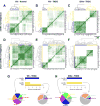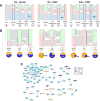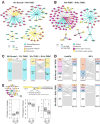Race Disparities in the Contribution of miRNA Isoforms and tRNA-Derived Fragments to Triple-Negative Breast Cancer
- PMID: 29229607
- PMCID: PMC5935570
- DOI: 10.1158/0008-5472.CAN-17-1947
Race Disparities in the Contribution of miRNA Isoforms and tRNA-Derived Fragments to Triple-Negative Breast Cancer
Abstract
Triple-negative breast cancer (TNBC) is a breast cancer subtype characterized by marked differences between White and Black/African-American women. We performed a systems-level analysis on datasets from The Cancer Genome Atlas to elucidate how the expression patterns of mRNAs are shaped by regulatory noncoding RNAs (ncRNA). Specifically, we studied isomiRs, that is, isoforms of miRNAs, and tRNA-derived fragments (tRF). In normal breast tissue, we observed a marked cohesiveness in both the ncRNA and mRNA layers and the associations between them. This cohesiveness was widely disrupted in TNBC. Many mRNAs become either differentially expressed or differentially wired between normal breast and TNBC in tandem with isomiR or tRF dysregulation. The affected pathways included energy metabolism, cell signaling, and immune responses. Within TNBC, the wiring of the affected pathways with isomiRs and tRFs differed in each race. Multiple isomiRs and tRFs arising from specific miRNA loci (e.g., miR-200c, miR-21, the miR-17/92 cluster, the miR-183/96/182 cluster) and from specific tRNA loci (e.g., the nuclear tRNAGly and tRNALeu, the mitochondrial tRNAVal and tRNAPro) were strongly associated with the observed race disparities in TNBC. We highlight the race-specific aspects of transcriptome wiring by discussing in detail the metastasis-related MAPK and the Wnt/β-catenin signaling pathways, two of the many key pathways that were found differentially wired. In conclusion, by employing a data- and knowledge-driven approach, we comprehensively analyzed the normal and cancer transcriptomes to uncover novel key contributors to the race-based disparities of TNBC.Significance: This big data-driven study comparing normal and cancer transcriptomes uncovers RNA expression differences between Caucasian and African-American patients with triple-negative breast cancer that might help explain disparities in incidence and aggressive character. Cancer Res; 78(5); 1140-54. ©2017 AACR.
©2017 American Association for Cancer Research.
Conflict of interest statement
Conflict of Interest: None
Figures





References
-
- Siegel RL, Miller KD, Jemal A. Cancer statistics, 2016. CA Cancer J Clin. 2016;66:7–30. - PubMed
-
- Dawson SJ, Provenzano E, Caldas C. Triple negative breast cancers: clinical and prognostic implications. Eur J Cancer. 2009;45(Suppl 1):27–40. - PubMed
-
- Ademuyiwa FO, Edge SB, Erwin DO, Orom H, Ambrosone CB, Underwood W., 3rd Breast cancer racial disparities: unanswered questions. Cancer Res. 2011;71:640–4. - PubMed
Publication types
MeSH terms
Substances
Grants and funding
LinkOut - more resources
Full Text Sources
Other Literature Sources

